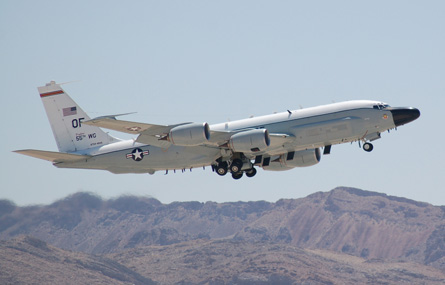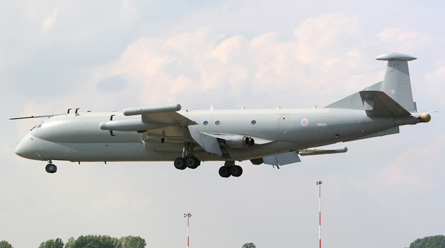L-3 Communications expects to receive approval in the second quarter of 2009 to supply RC-135 Rivet Joints to the UK Ministry of Defence, as replacements for its Royal Air Force fleet of three British Aerospace Nimrod R1 signals intelligence aircraft.
The MoD selected the US contractor last year for the Helix programme, which was expected to upgrade the electronic surveillance suite on the 51 Sqn-operated R1s, based at RAF Waddington, Lincolnshire.
L-3 chief executive Michael Strianese, however, told analysts on 24 July that the Helix upgrade could soon be abandoned. "The UK has been reconsidering that decision, and we understand it is considering purchasing Rivet Joints instead," he said.
 |
|---|
© Craig Hoyle/Flight International |
The RC-135 (above) is the backbone for the US Air Force's airborne electronic intelligence mission, with L-3 also acting as prime contractor for fleet upgrades.
Strianese says two major factors prompted the UK's interest in acquiring aircraft modified to the Rivet Joint standard. Firstly, the crash of Nimrod MR2 XV230 in Afghanistan in 2006 with the loss of 14 lives revealed that the "airframe was not quite as good as they thought", he says, with this having made it difficult to justify the cost of an expensive electronics upgrade.
Secondly, buying Rivet Joints offers the MoD the opportunity to improve interoperability with US forces, and to receive hands-on training with USAF crews before the first aircraft are delivered.
"I believe that the decision will get finalised in 'Main Gate' approval," says Strianese, who adds: "We will probably get a green light in the spring."
UK-based sources suggest that the Nimrod R1 fleet (XW664 pictured below) will now be retired around the same time as the RAF's remaining Nimrod MR2s. One notes that extending use of the type was deemed to be "politically unacceptable", given the widespread scrutiny of the type's safety, which has followed the loss of XV230.
 |
|---|
© Dragon Lady/AirSpace |
The MR2 will be replaced by the BAE Systems Nimrod MRA4, nine of which are under contract. Flight testing of the new type is scheduled to conclude by year-end, with the first four to enter service at RAF Kinloss in Scotland by late 2010.
The MoD confirms that it is "currently considering an acquisition of the Rivet Joint system", but adds: "no decisions have yet been made with regard to the selection of the mission system or the host platform for the [Helix] capability."
Additional reporting by Craig Hoyle
Source: Flight International























